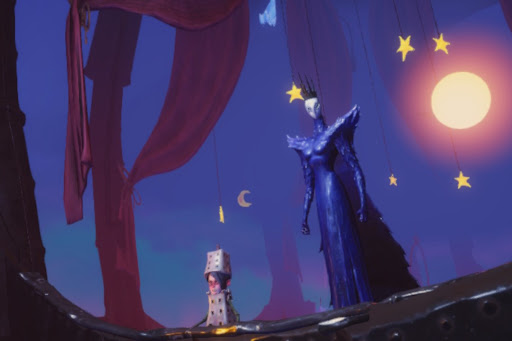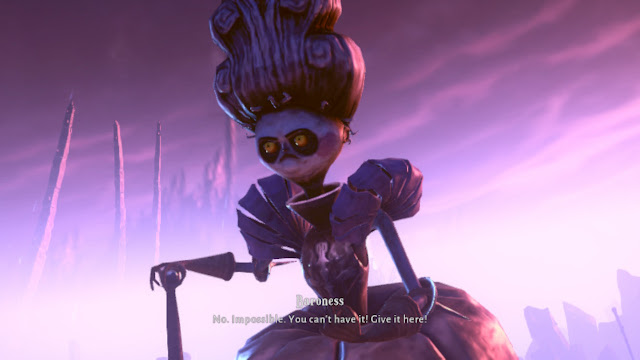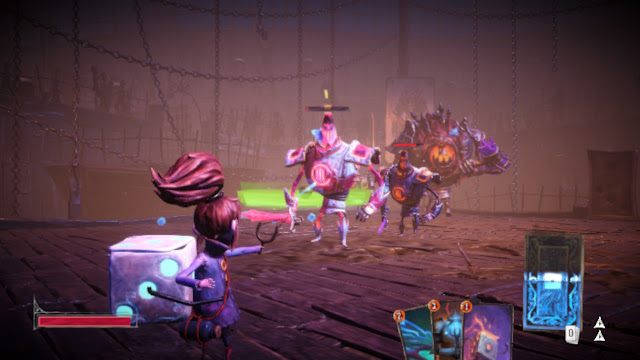Lost in Random loves a fantasy storytelling trope. Utterly adores them, in fact, because so very much of its narrative attraction lies in the way it tells what is otherwise a pretty standard tale.
Stop me if you’ve heard this one before. Evil queen. Dark magics from beyond the realm of the normal. An oppressed people, crying out to be free. A young champion from the wrong side of the tracks who will rise up and…
Yeah, you’ve already started to nod off, haven’t you?
You shouldn’t, though, because Lost in Random takes those tropes and rolls the dice with them – quite literally. It’s set in the world of Random, a world split up into six regions to match the six faces of a standard die. Yes, that does mean that when your character cannot locate where she is, she’s literally Lost in Random.
Dice play a pivotal role in Lost in Random’s magic, with the world’s evil queen deciding the fate of every youngster when they reach the age of 12 via a roll on her black and evil die. Only those with the best luck get a six, and go to live happily with the queen forever.
I think you can see where this is heading, but as is so often the case with narrative adventures, it’s not really about the destination but the way the journey plays out. You play as Even, a young girl whose sister Odd (get used to the dice-related puns) is taken by the Queen after a dice roll that may not have been on the level. I know, evil queens doing dastardly acts – it’s unheard of, right?
(One quick aside: If you’re going to play Lost in Random, get used to characters getting the difference between the singular (“Die”) and plural (“Dice”) wrong many, many times.)
By its nature, this has to be a slightly unusual review, because I really don’t want to talk too much about the core narrative, because it’s easily the most enjoyable part of the game. Along the way Even explores the nature of luck, mortality, the way children are raised and even the way we interact with games through her interactions with Random’s array of citizens and rulers, as well as the omniscient narrator providing context.
It’s well worth seeking out Lost in Random’s sidequests, not so much because they give you in-game boons, but more because they really do flesh out the world and give you access to more of the game’s genuinely entertaining writing.
Even starts out in her hometown of Onecroft, and has to make her way through the game’s six worlds to rescue her sister. Each town is defined both by its role in Random’s economy and the habits of its inhabitants. Oners get to harvest junk and live in a pretty crappy little city, but it’s home for Even and Odd. Or at least it was. The people of Two-Town have split personalities and a mayoral problem. Again, I don’t want to spoil too much, but it builds wonderfully from a very simple start.
Even sets out and quickly discovers her travelling companion. A living die, called Dicey, who speaks in that kind of simulated garbled nonsense that EA also loves in the Sims games. Everyone (but you) can understand Dicey, however, and it’s through him that you get access to the game’s combat mechanics. Of course, everyone knows that the Queen has destroyed all the dice, so Even has to sometimes argue her way around her unusual travelling companion.
The combat is… dicey. For once, I’m not punning here, either.
At predetermined locations you’ll end up in combat, which is where Lost in Random’s mix of dice and deck building comes into play. As Even explores her world she’ll unlock and buy a variety of combat-centric cards that allow her access to weapons, healing buffs and combat altering “cheat” cards.
When you enter into combat, your first task will be to break energy crystals using your slingshot. Get enough crystals and you can fill out your hand, chosen randomly from the 15 card deck you can build.
You then roll Dicey. The number you get gives you a score you can then use to play individual cards in real-time combat. It’s a reasonably graceful system, and there’s some genuine joy to be had working out effective combinations, as well as working out how to survive when you get either a dud hand or a low roll. There’s even cheat cards that can ensure high rolls (relative to Dicey’s current highest number of pips) to add to the strategic fun.
However, it’s rather undone by a lack of variety and grind. You’ll face the same mostly stupid robots again and again and again. At the default difficulty level, they’re not hard to defeat, but they do have large health bars, which means battles grind on for longer than they should. You can drop the difficulty down, which lessens their health, but this just highlights the imbalance of the combat dynamics. Boss fights are a little better in terms of variety at least, but the combat isn’t what carries Lost in Random.
It’s the narrative, supplanted by a gorgeous Claymation style visual design that can’t help but bring to mind classics like Tim Burton’s The Nightmare before Christmas or Neil Gaiman’s Coraline. Everything is dark and moody, and each town has its own distinct identity and characteristics that still fit into the game’s dark gothic style. It’s an unusual title to see EA publishing, given its general flex towards annual sports and FPS game updates, but it is quite a welcome one.
Lost in Random isn’t a terribly long game. Even if you do keep the battles long by maintaining normal difficulty you can knock it off in around a dozen hours or so of gameplay time. By that stage, you probably won’t find the combat as charming as you did when you first started, but you’ll still want to see it to its conclusion, because the narrative and humour are so particularly strong.
Well done, EA. See, you can publish a decent game, free of horrible microtransactions, every once in a while. Now, where’s that Polterguy sequel I’ve been waiting decades for?
Alex Kidman.
Contributor












